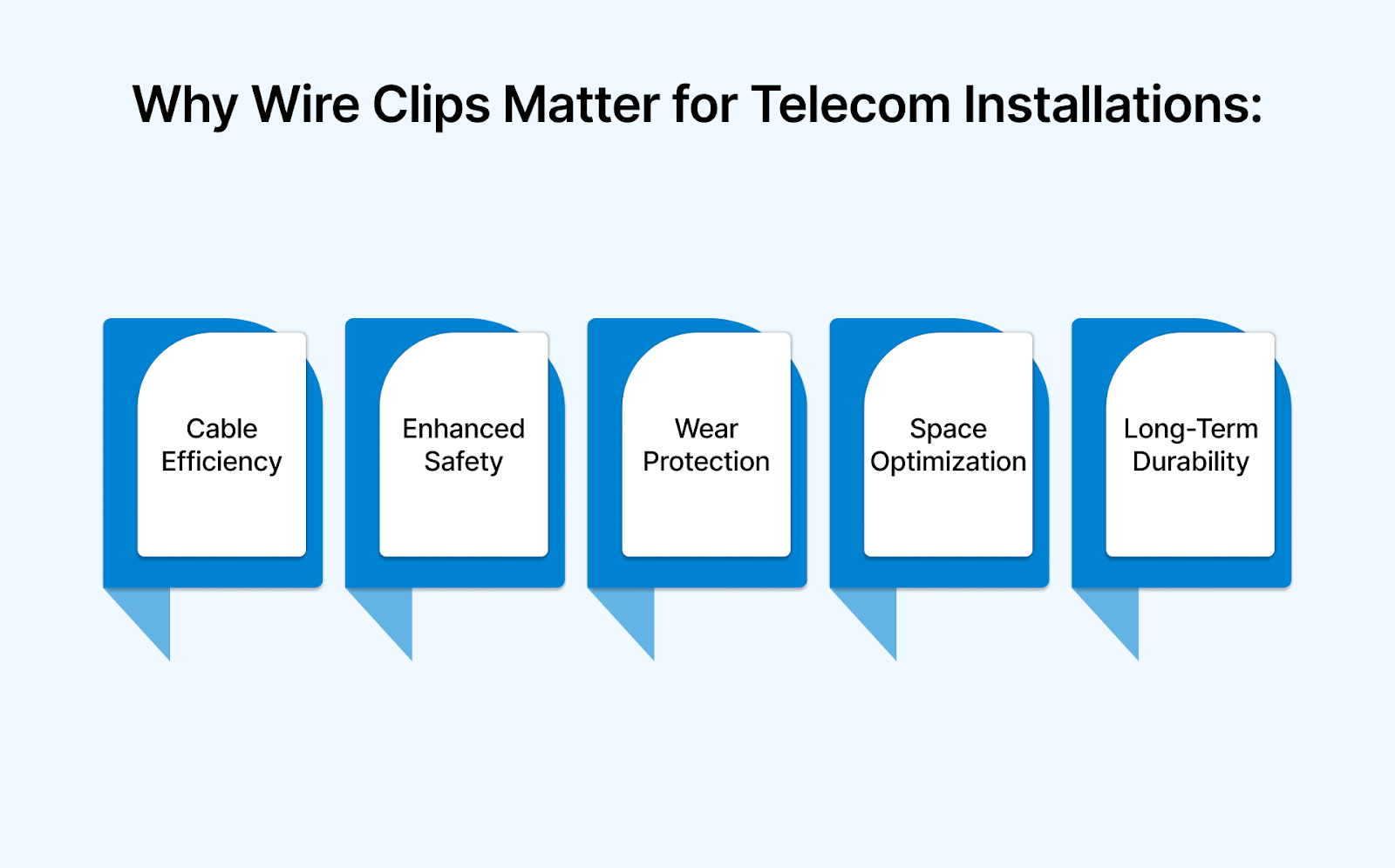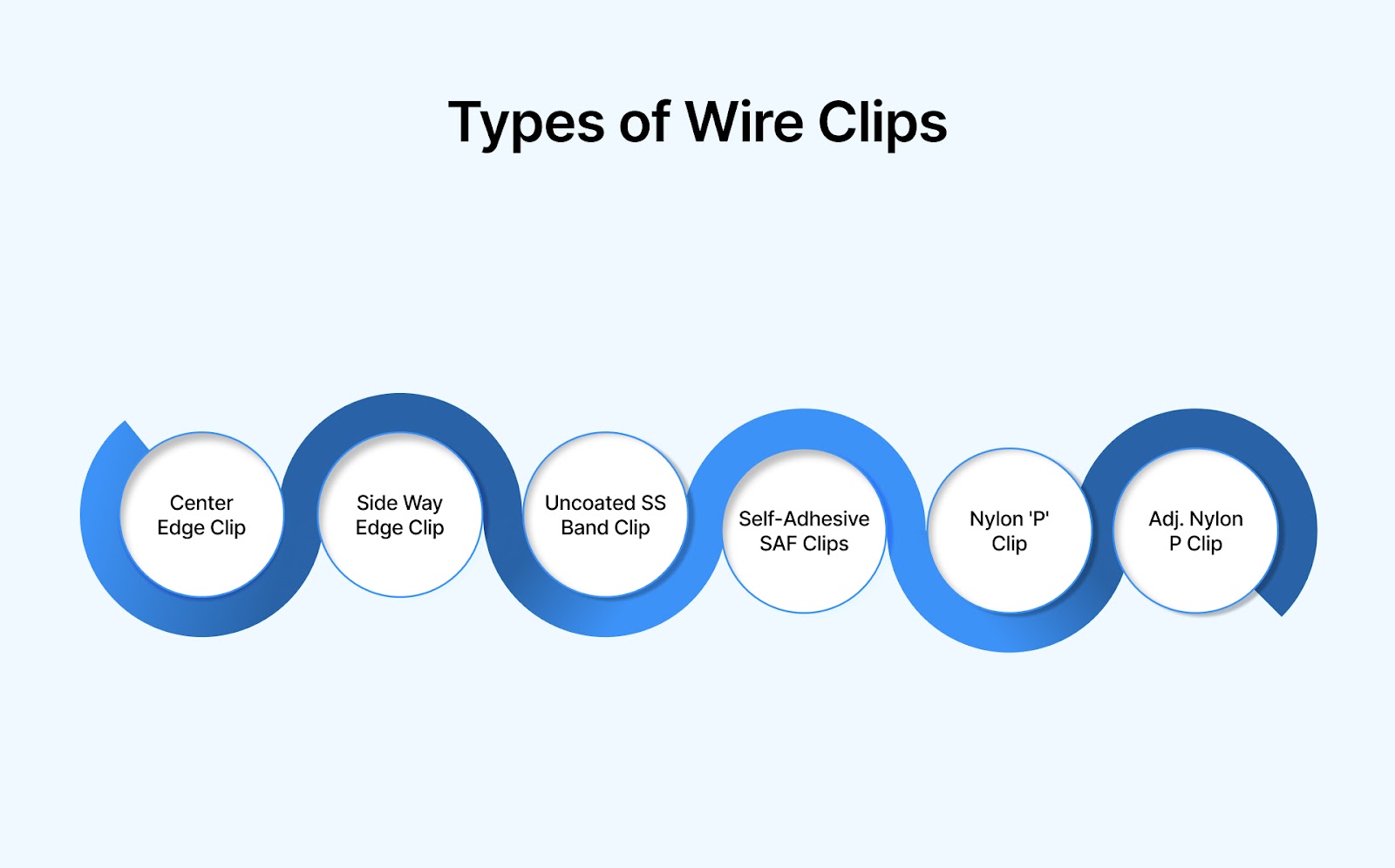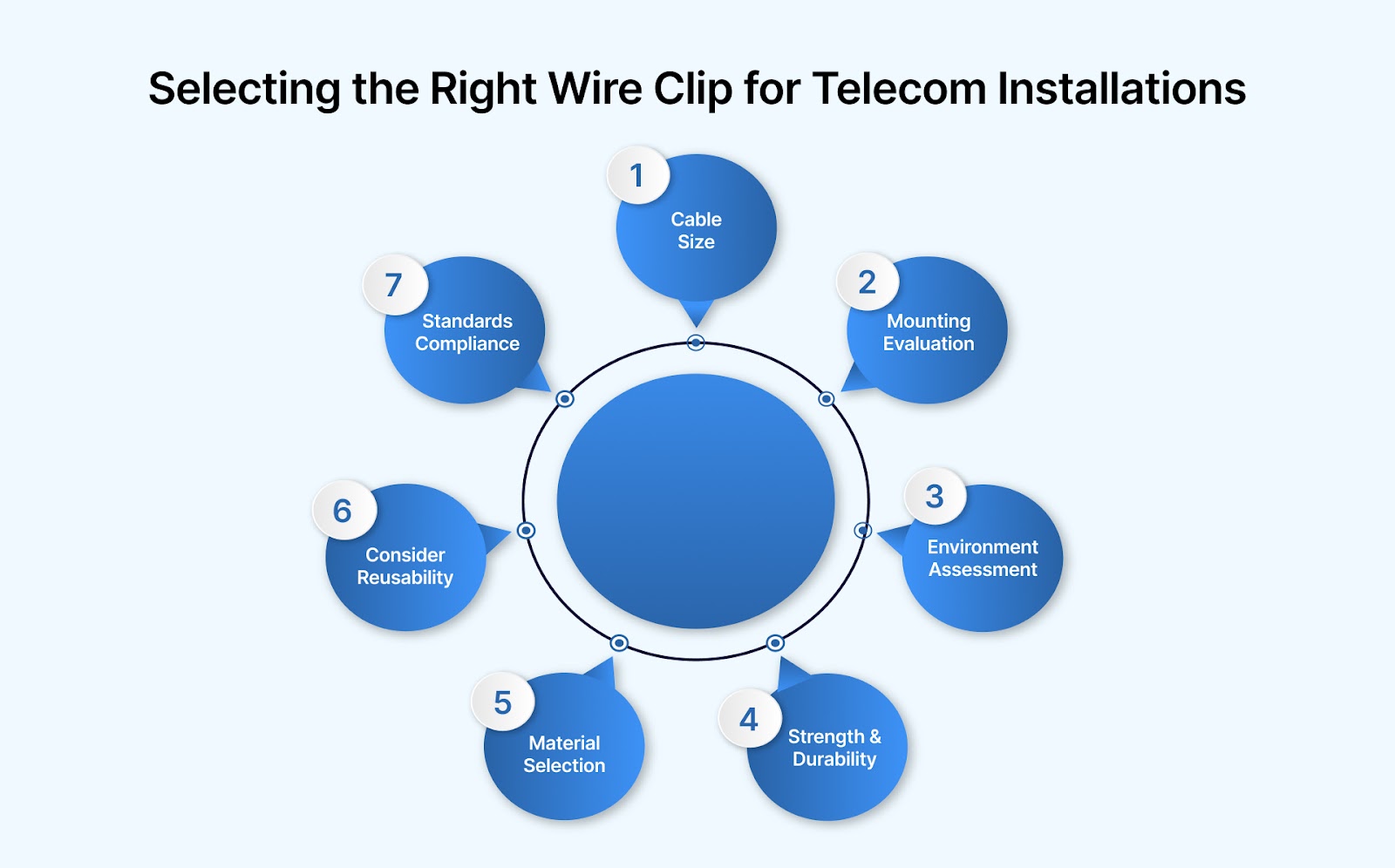How to Use Wire Clips in Telecom Installations
July 30, 2025

Are you struggling with disorganized cables in your telecom setup, leading to downtime, inefficiency, and safety risks? Proper cable management is crucial in telecom installations to ensure a clean setup, protect your equipment, and boost system reliability. Disorganized wires can create clutter, increase the risk of damage, and even interfere with network performance.
That’s where wire clips come in. Simple yet incredibly effective, wire clips provide the perfect solution for organizing and securing cables. By using the right clips, you can eliminate the mess, streamline maintenance, and prevent costly service disruptions.
In this blog, we’ll walk you through everything you need to know about how to use wire clips in telecom installations. We’ll explore the different types of clips, the applications they serve, and how to select the right clip for your specific needs to get your telecom setup in top shape.
Understanding Wire Clips and Their Importance in Telecom Installations
Wire clips or cable clips are essential components designed to secure and organize cables, ensuring they stay in place while preventing tangling or damage. These clips are available in various shapes and sizes and are made from materials such as nylon or steel, catering to different installation environments.
Their primary function is to hold cables securely against a surface, providing structure and reducing the risk of accidental damage.
Why Wire Clips Matter for Telecom Installations:

Wire clips play a crucial role in ensuring the smooth operation of telecom installations. By keeping cables organized and secure, they help maintain system integrity and simplify future maintenance or troubleshooting. Here’s how they can help:
- Efficient Cable Management: Wire clips keep cables neatly arranged, reducing clutter and making it easier to maintain and troubleshoot telecom networks.
- Enhanced Safety: Wire clips help reduce the risk of accidents in both indoor and outdoor environments by preventing cables from tangling or becoming a tripping hazard.
- Protection Against Wear and Tear: Wire clips shield cables from external damage, including abrasion and exposure to harsh weather conditions, which can lead to system malfunctions.
- Space Optimization: They allow for better organization within tight spaces like server rooms, telecom cabinets, or along walls, optimizing the available area for other components.
- Long-Term Durability: Well-secured cables are less likely to experience physical stress, ensuring longevity and reliable performance of telecom installations.
Now that we’ve defined wire clips and their importance, let’s explore the different types you can use for your telecom setup.
Types of Wire Clips

Wire clips come in several designs, each offering a unique approach to securing and organizing cables. Understanding the specific types of wire clips can help you select the best option for your telecom installations. Here are some of the most common types:
- Center Edge Clip: This two-piece clip is used with cable ties for applications where drilling holes or adhesive mounts are not feasible. Commonly used in automotive, wire harnessing, electrical, and panel building.
- Side Way Edge Clip: This two-piece clip, used with cable ties, is designed for applications where drilling holes or adhesive mounts are not possible. The clip features a nylon body with a metal clamp and can be easily push-fitted onto metal chassis to secure cables in any direction—vertical, horizontal, or at an angle.
- SS Clip HD for SS Band Uncoated: Designed for use with heavy-duty stainless steel bands, this clip is also compatible with light-duty and coated bands.
- Self-Adhesive SAF Clips: Designed for holding single or multiple cables, these clips feature a low profile and a soft steel center hook. This allows for easy cable fixing and removal by simply pressing or pulling with a finger. The adhesive backing provides a long-lasting bond on a variety of clean and flat surfaces.
- Nylon 'P' Clip: A versatile clip that holds cables, tubes, and other components. It offers both fixed and adjustable designs for various wire and cable diameters. Easy mounting with screws makes it a practical choice for a wide range of applications.
- Nylon 'P' Clip Perforated Adjustable: This perforated adjustable version offers the flexibility to hold cables, tubes, and components with different diameters. The perforations facilitate easier installation with screws, making it highly adaptable and user-friendly.
Need the right wire clips for your telecom setup? Surelock offers a comprehensive range of cable ties and clips, including durable metal and adhesive options, designed to meet the specific needs of your telecom installations. Explore our full product line to find the perfect solution for your project.
Having identified the various wire clips, let’s look at the key differences between cable clamps and clips to make sure you're selecting the right one.
Cable Clip Vs Clamp: The Difference
When selecting the right solution for securing cables, it’s essential to understand the difference between cable clips and cable clamps. Though they might seem similar, each serves a unique purpose in cable management, depending on the installation requirements. Let’s break down the key differences between cable clips and clamps:
Understanding the distinction between clamps and clips is crucial. Next, we’ll dive into the top applications of wire clips in telecom installations.
Also read: Cable Ties vs Zip Ties: Key Differences Explained
Top Applications of Wire Clips in Telecom Installations
Wire clips are vital in organizing and securing cables in telecom installations. They ensure a streamlined setup, reduce potential damage, and contribute to long-term system reliability. Below are the key applications of wire clips in telecom setups:
- Cable Organization on Panels: Wire clips help keep cables neatly arranged on telecom panels, reducing clutter and preventing cables from tangling or interfering with equipment. This ensures better airflow and easier maintenance access.
- Surface Mounting: Wire clips attach cables securely to walls, ceilings, or floors. This prevents cables from hanging loosely and causing safety hazards while also allowing for quick and easy installation or adjustments.
- Routing Cables through Electrical Enclosures: Wire clips keep cables in place in telecom enclosures or cabinets, preventing them from shifting during operation or maintenance. This also protects cables from external elements or mechanical damage.
- Securing Cables in High-Vibration Environments: Certain telecom installations, such as those in mobile towers or communication equipment rooms, can experience vibrations. Wire clips provide a stable and secure hold on cables, minimizing the risk of damage caused by vibrations.
- Guiding Cables around Corners and Tight Spaces: Wire clips are essential for routing cables along corners, curves, or confined spaces without damaging the wire insulation. They provide a controlled path for cables to travel, ensuring neatness and avoiding stress on the cables.
- Support for Fiber Optic Cables: Wire clips are particularly useful for managing delicate fiber optic cables. They provide a secure grip without exerting excessive pressure that could lead to signal degradation.
- Easy Maintenance and Troubleshooting: When cables are secured using wire clips, troubleshooting becomes easier. Well-organized cables are more accessible, allowing technicians to quickly identify faults, replace damaged cables, or perform upgrades without dealing with a tangled mess.
From securing cables along panels to organizing wire bundles in tight spaces, Surelock provides top-notch cable management solutions tailored to telecom installations. Browse our selection of high-performance wire clips and ensure your cables stay safe and organized throughout your installation.
Now that we’ve covered where wire clips are used, let’s move on to how to select the perfect wire clip for your needs.
Also read: 10 Industrial Use Cases for Cable Ties
Selecting the Right Wire Clip for Telecom Installations

Choosing the right wire clip is crucial for ensuring the safety, efficiency, and longevity of your telecom setup. The wrong clip can damage the cable, cause inefficient management, and safety issues. Here’s how to select the ideal wire clip for your telecom installations:
- Consider the Cable Size: Ensure the clip’s size matches the diameter of the cable you’re securing. The clip should hold the cable snugly without squeezing it too tightly, as excessive pressure can damage the cable. Check the clip’s specifications for compatible cable diameters.
- Evaluate the Mounting Surface: Wire clips come with different mounting options. Adhesive-backed clips are ideal for smooth surfaces, while screw-mount clips work best for rough or uneven surfaces. For high-vibration areas, choose clips with secure and adjustable features.
- Assess the Environment: Different installations require clips that can handle specific environmental conditions. If your telecom setup is exposed to outdoor elements, choose UV-resistant, weatherproof, or corrosion-resistant wire clips, such as those made from stainless steel or specially coated materials.
- Strength and Durability: Ensure the wire clip can withstand the physical demands of your installation. For heavier cables, such as those used in power or fiber-optic applications, choose clips with higher tensile strength and the ability to hold cables firmly in place over time.
- Material Selection: Wire clips are made of various materials, such as nylon, or metal. Metal clips are stronger and more durable, suitable for heavy-duty applications, while plastic clips are lightweight and cost-effective for lighter installations.
- Consider Reusability: If you anticipate frequent adjustments or re-routing of cables, select clips that are easy to remove and reattach without damaging the clip or the cable. Reusable clips with locking mechanisms provide flexibility for future changes.
- Comply with Standards: Always check the wire clip’s compliance with relevant industry standards and regulations, particularly in telecom installations. Ensure the clips meet safety standards to avoid any regulatory issues or hazards.
Choosing the right wire clip is crucial to the success of your telecom installation.
Now that you know how to choose the right wire clip, it’s time to learn how to use them correctly in your telecom setup.
How to Use Cable Clips in Telecom Installations: 10-Step Process
Using cable clips effectively is crucial for organizing telecom wiring and ensuring a safe, efficient setup. Here's how to do it properly, step-by-step:
- Assess the Installation Area: Before you start, examine the space where the cables will be installed. Consider factors like available surfaces (walls, panels), proximity to power sources, and environmental conditions (temperature, humidity).
- Choose the Correct Clip Type: Ensure you're using the right wire clip for the type of cable and surface you're working with. Whether it's an adhesive mount or screw-based clip, each clip type is suited to specific materials and installation environments.
- Gather Necessary Materials: Collect the required tools and materials:
- Wire clips (the appropriate type)
- Cables
- Screwdriver (if using screw-mount clips) or adhesive
- Drill (for screw-mount clips)
- Plan Cable Routing: Before attaching any clips, map out the cable route. Ensure the cables are straight, avoid sharp bends, and leave some slack for flexibility.
- Attach the Clips to the Surface:
- For Adhesive Clips: Peel off the backing, place the clip securely on the surface, and press firmly for a few seconds to ensure the adhesive sticks properly.
- For Screw-Mount Clips: Align the clip with the marked area and insert a screw into the clip's hole. Tighten with a screwdriver, ensuring the clip is secure but not over-tightened to avoid damaging the surface or clip.
- Position the Cable in the Clip: Place the cable into the clip's cradle or holding area. Ensure the cable sits comfortably without being forced or bent sharply. The clip should hold the cable firmly, but there should be some slack to allow for flexibility.
- Secure the Cable: If your clip includes an additional securing mechanism (e.g., a locking tab or additional tightening), ensure the cable is fully locked into place. Double-check that the cable isn't under too much tension, which could cause damage over time.
- Repeat the Process for All Cables: Continue the process, spacing clips evenly along the cable route. Make sure the cables are neatly organized and secure at each point, avoiding any loose or sagging areas.
- Check for Proper Cable Management: After all clips are in place, visually inspect the installation. Ensure cables are routed neatly, with no excessive slack, and that clips are securing the cables without stress or strain.
- Final Check for Stability: Tug gently on the cables to make sure they’re securely fastened in the clips. Ensure that the clips are firmly attached to the surface and that the cables won’t move easily, preventing any future disruptions or damage.
By following these steps, you can effectively use wire clips in telecom installations to ensure a clean, secure, and reliable cable management system. Next, we’ll focus on properly maintaining wire clips for long-lasting effectiveness.
Maintaining Wire Clips in Telecom Installations
Proper maintenance of wire clips is essential to ensure long-term reliability and efficiency in telecom installations. Regular checks and care help prevent issues like cable damage, loose clips, or disrupted systems. Here's how to maintain your wire clips effectively:
- Regular Inspections: Periodically check all installed wire clips for any signs of wear or damage. Look for cracks, broken parts, or loosening of clips that could make cables unsecured.
- Ensure Proper Fit: Over time, clips may loosen, especially in high-vibration environments. Ensure the clips hold cables snugly without overstretching or losing grip.
- Clean the Clips and Area: Dust, debris, or grime buildup can affect clip performance. Clean clips regularly using a soft cloth or compressed air, ensuring that no material obstructs the clip or surface adhesion.
- Check for Cable Strain: Ensure the cables are not under too much tension or bending excessively within the clips. Adjust or reposition clips if necessary to relieve any strain and prevent potential damage to the cables.
- Replace Damaged Clips Immediately: If a clip is broken or shows signs of stress, replace it promptly. Using damaged clips can lead to poor cable management and may cause cables to become loose or tangled over time.
- Monitor for Environmental Factors: Regularly evaluate the environmental conditions around your installation—temperature fluctuations, humidity, or exposure to UV rays can degrade clips, especially plastic ones. Replace clips that have become brittle due to environmental wear.
- Maintain Adhesive Clips: For adhesive-mounted clips, ensure that the adhesive remains intact. Over time, the adhesive may lose its grip, especially in high-temperature or humid environments. Replace or reapply adhesive as needed to keep the clips secure.
- Reorganize Cables as Needed: Over time, the arrangement of your cables might change. Periodically review cable routing to ensure that clips still effectively hold cables in their intended positions, adjusting as necessary for new equipment or layout changes.
By following these maintenance tips, you'll keep your wire clips in optimal condition, ensuring that your telecom system stays organized, secure, and efficient for years to come.
Conclusion
Properly using wire clips in telecom installations is key to ensuring a secure, organized, and efficient system. From selecting the right clip to regular maintenance, following these best practices will help you avoid common issues and keep your cables in place for years to come.
At Surelock, we specialize in high-quality cable management solutions, offering a wide range of wire clips, cable ties, and mounting accessories designed to meet the demands of telecom installations. Whether you're working with delicate wiring or heavy-duty cables, Surelock provides the reliability and durability your project requires.



